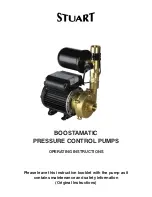
Section V - Options
Quincy Vacuum Pump-QSV Series 71
Reference
Description
1
Water inlet pipe
2
Water outlet pipe
3
Oil line from vacuum pump oil separator vessel to HE unit
4
Oil line from HE unit to oil filter housing
BV
Electronic thermostatic valve
OF
Oil filter
HE
Heat exchanger
Field installation
The main components are assembled ex-factory as a compact unit which fits inside the bodywork of the
vacuum pump. Consult Quincy for installing and connecting the energy recovery unit.
5.2 Energy recovery systems
General
The energy recovery systems can be applied as low temperature rise/high water flow systems or as high
temperature rise/low water flow systems.
Low temperature rise/high water flow systems
For this type of application, the temperature difference between the water in the energy recovery system and
the vacuum pump oil is low. As a consequence, a high water flow is needed for maximum energy recovery.
Example: The heated water is used to keep another medium at a moderately high temperature, in a closed
circuit, e.g. central heating.
High temperature rise/low water flow systems
For this type of application, a high water temperature rise in the energy recovery system is obtained, which
consequently brings on a low flow rate.
Example: An open circuit where cold water from a main supply is heated by the energy recovery system for
use in a factory, e.g. pre-heating of boiler feed water.
Recovery water flow
The recovery water enters the unit at inlet connection (1). In heat exchanger (HE) the compression heat is
transferred from the vacuum pump oil to the water. The water leaves heat exchanger (HE) via outlet
connection (2).
Water requirements for closed water circuits
The use of a closed water circuit minimises make-up water requirements. Therefore, the use of soft or even
demineralised water is economically feasible and eliminates the problem of scale deposits. Although the
heat exchanger water circuit is made of stainless steel, the water circuit connected to the vacuum pump.
Consult section Cooling water requirements to minimise problems due to bad water quality. If in any doubt,
consult Quincy.
Add an anti-freeze product such as ethylene-glycol to the water in proportion to the expected temperature to
avoid freezing.
Water requirements for open water circuits
For open, non-recirculation water circuits, the major problems usually encountered are related to deposit
control, corrosion control and microbiological growth control. To minimize these problems, the water should
meet a number of requirements. See section Cooling water requirements. If in any doubt, consult Quincy.
Содержание QSV 2200
Страница 1: ...Quincy Oil sealed rotary screw vacuum pumps QSV 2200 QSV 2700 QSV 3200 Instruction Manual...
Страница 2: ......
Страница 4: ...This page intentionally left blank...
Страница 14: ...Section II General description 14 Quincy Vacuum Pump QSV Series Open view front Open view back...
Страница 61: ...Section IV Installation Quincy Vacuum Pump QSV Series 61 Installation 4 1 Dimension drawings...
Страница 62: ...Section IV Installation 62 Quincy Vacuum Pump QSV Series 4 2 Installation proposal...
Страница 119: ...Section XII Declaration of conformity Quincy Vacuum Pump QSV Series 119 Declaration of conformity...
Страница 122: ...Notes 122 Quincy Vacuum Pump QSV Series...
Страница 123: ......
Страница 124: ...www quincycompressor com No 6996 0227 39 2017 09 Printed in USA...
















































